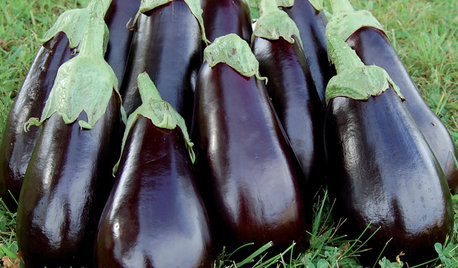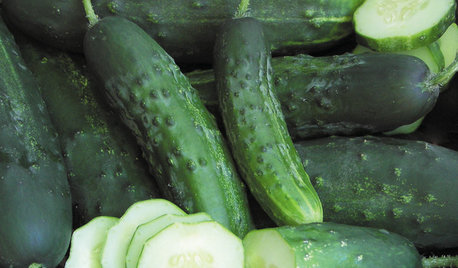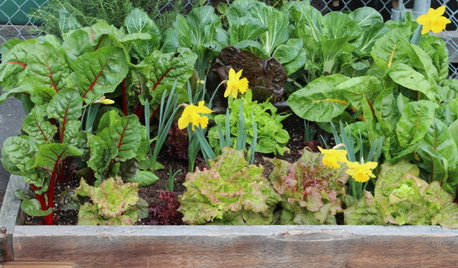I am trying some new hybrid tomato varieties this year that actually have been bred for flavor. Although it would sound logical that all vegetable hybrids would be bred "for flavor", the truth is that many have not been. In fact, for several decades, tomato breeders in specific have been breeding for characteristics desired by commercial growers which means they've been breeding tomatoes that are produce round, red fruit with smooth shoulders on shorter, determinate plants that are easier to machine-harvest; thick skin that ships well; long-holding capability so that tomatoes have a long shelf-life in the store and at your home, and disease-resistance.
To make matters worse, large-scale commercial growers pick tomatoes and process them while still green, holding them in refrigerated buildings, shipping them in refrigerated trucks and exposing them to gases that cause them to turn red but NOT to actually ripen. So, when you buy a grocery store tomato that wasn't even necessarily bred for good flavor to begin with, you're also getting a fruit whose flavor has been destroyed by being picked green and gassed to redden it, and whose texture has been destroyed by refrigeration. Is it any wonder that most grocery store tomatoes have mealy, mushy flesh inside, thick skin outside and are flavorless in comparison to any homegrown tomato?
One reason the heirloom vegetable movement has thrived and grown is because people want vegetables in general, and tomatoes in particular, that taste good! Also, just because the commercial industry decided long ago that the "perfect tomato" was a red, globe-shaped, smooth-shouldered fruit....well, that doesn't mean they were right! It is a shock to many people to discover that you can grow (and eat!) tomatoes that have skin and flesh in many colors including black (not true black, but mostly a maroonish-mahogany-greenish color), purple (very dark pink), pink (pale red to pinkish red), orange (many shades from bright orange to golden orange), yellow (from pale ivory-yellow to lemon yellow to golden-yellow), white (from pale cream to dark ivory, but not really a "bright white") to green-when-ripe types that often are partially green but take on an amber-to-green shade when fully ripe. It also can be quite a shock to folks to experience the amazing flavor of heirloom types.
So, has the commercial gardening world noticed that many home gardeners, market growers and small farmers have rejected most or all modern-day hybrids in favor of heirlooms? Of course they have.
For several decades some researchers actually have tried to figure out how to breed for flavor. Over time, they have determined that tomato flavor arises from the complex combinations of about 10 or more volatile compounds found in tomatoes. At one point some researchers thought they had found "the" compound that would give tomatoes the best flavor and it is a compound called furaneol. However, when they tested tomatoes for that compound, they found most contained about the same amount of furaneol so they decided that they were wrong.
Well, they weren't wrong after all. Better testing methods developed in more recent years have found that tomatoes do contain widely varying amounts of furaneol and, lo and behold, tomatoes widely perceived as having "better flavor" do have higher levels of furaneol. Having discovered they were right about furaneol all along, the researchers and breeders began trying to find the gene associated with higher furaneol levels....and they found it.
During recent years, scientists have developed the ability to manipulate that gene, thereby producing tomatoes with higher levels of furaneol. We are starting to see the results of that gene manipulation in some tomato varieties now appearing on the market. So, now tomato breeders believe they are giving us hybrid tomatoes that are determinate, have good disease-resistance to some of the major tomato diseases, are very productive in terms of number of fruit per plant, AND have good flavor. It sounds too good to be true.
Some of these tomato varieties have been winning taste tests conducted by researchers the last few years, and some commercial growers and some folks who test new varieties for the AAS program hav been growing them for a couple of years now.
I tracked down some of these new varieties after reading about them in articles linked by posters on the Tomato Forum here at GW. There are several of these higher-furaneol tomatoes available commercially although sometimes you really have to search to find affordable seed in quantities sized for a home gardener. The varieties mentioned as being higher in furaneol include Fabulous (available from Park Seed and naturally high in furaneol), SecuriTY 28 (higher in furaneol and also resistant to Tomato Yellow Leaf Curl Virus), Scarlet Red, Red Defender (high in furaneol and shows intermediate resistance to Tomato Spotted Wilt Virus) and Mountain Glory (not only higher in furaneol but also has resistance to Tomato Spotted Wilt Virus).
Of these tomatoes, I am trying these varieties this year: Scarlet Red, Red Defender and Mountain Glory.
I am hopeful that the researchers have given us better-flavored tomatoes with all the positive attributes of modern-day hybrids, but the only way to find out is to try them and see for myself.
Will modern-hybrids ever replace heirlooms? I think they absolutely will not. However, it would be great if they could give us great-tasting modern hybrids that would complement the many wonderful flavors found in the thousands of heirlooms available through commercial sources and seed savers.
When I was a kid, we grew mostly heirlooms (although we didn't call them that) and our favorites were regional varieties for which the growers often obtained their seed from the now-defunct Gene Porter and Sons Co. which was based in Texas, where I lived at the time. As various hybrids came along, my dad always tried them, but he remained true to a couple of the good-flavored older hybrids from the early decades of the 20th century and to a few open-pollinated ones as well. As a young adult married and gardening on my own away from dad, I tried a lot of the hybrids as they were introduced and often found them lacking in flavor. So, over the years I grew fewer and fewer hybrids and more and more heirlooms.
Although I have mostly focused on heirlooms the last 10-15 years, I've continued to search for good-flavored hybrids and have found there are a few. We especially like the flavor of Brandy Boy, Big Beef, Beefmaster, Porterhouse, Little Brandywine, Bucks County, Better Boy, Supersonic, Primetime, JetStar and Ramapo. I am hopeful that after trying the new higher-furaneol tomatoes, I may be able to add a few more tomatoes to that list.
And, tomato taste is higher subjective and very dependent on any given person's taste buds. So, a variety I love you might hate and vice versa. Still, there are a few tomatoes--Brandywine being one--that are universally viewed as having superior flavor.
And, this whole discussion really has been about larger tomatoes--because the small-fruited ones like the grape, currant, cherry and pear-shaped types--often have very good flavor whether they are heirloom or hybrid.
I've linked one article below that describes how some of these higher-furaneol tomatoes have fared in taste tests.
Dawn
Here is a link that might be useful: Results From One Set of Tomato Trials













tomatomanbilly
Okiedawn OK Zone 7Original Author
Related Discussions
Does growing edibles in containers change the flavor?
Q
What is the best flavored green plum/plum hybrid?
Q
Flavor -- Acid Sweet Fruity -- Golden Gem Hybrid from Park's
Q
Beefsteak Hybrid's flavor & production?
Q
elkwc
soonergrandmom
Okiedawn OK Zone 7Original Author
scottokla
elkwc
Okiedawn OK Zone 7Original Author